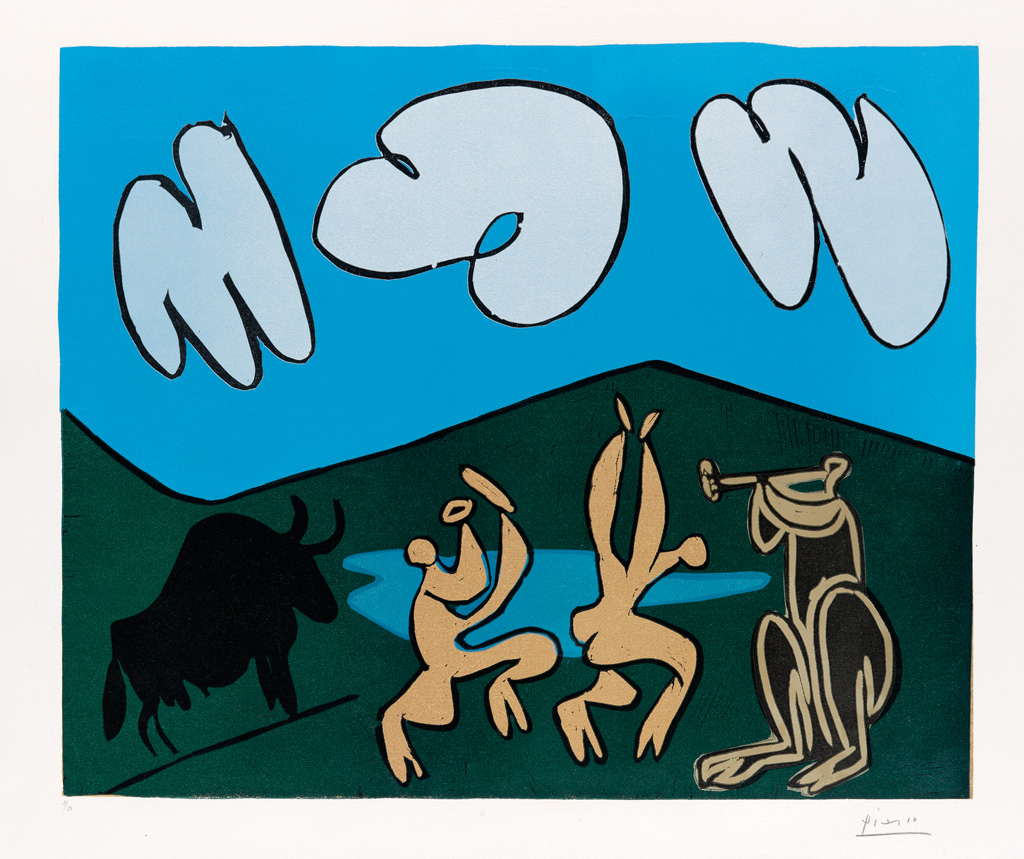Sale 2363 - Lot 410
Unsold
Estimate: $ 70,000 - $ 100,000
PABLO PICASSO
Bacchanale au Taureau noir.
Color linoleum cut, 1959. 525x638 mm; 20 3/4x25 1/8 inches, full margins. Signed and numbered 2/50 in pencil, lower margin. Printed by Arnéra, Vallauris. Published by Galerie Louise Leiris, Paris. A superb, richly-inked impression of this large, important print, with vibrant colors. Bloch 935; Baer 1253.
Pablo Picasso (1881-1973) produced more than 20,000 artworks in a wide variety of media over the course of his long, steady career--and more than 2,400 of these works were etchings, lithographs, woodcuts, drypoints and linoleum cuts. While many artists by his time simply used printmaking as a means to disseminate their work, Picasso was an exemplar in a lineage of artists including Dürer, Rembrandt and Goya who treated printmaking and its varied mediums as art forms all on their own. His work encompasses an enormous range of styles and movements, across realism and abstraction, and including Cubism, Neoclassicism, Surrealism and Expressionism. Picasso made his first prints after he moved from his home country of Spain to Paris in 1900, and returned briefly to printmaking in the 1930s, but the majority of his prints were produced after World War II in close partnership with various Parisian printmaking / publishing houses. Ceaselessly experimental, Picasso viewed printmaking as a way of tracking the evolution of his thoughts, i.e. he could preserve an idea through a print and then continue to build on the concept by revisiting the same plate or stone.
Picasso began his prolific career with a focus on etching, and gained expertise in collaboration with the Parisian master printers Eugène Delâtre, Louis Fort and Roger Lacourière. Coinciding with his Rose Period (or Circus Period) of painting, Picasso's first series of etchings (from 1905) are generally known as La Suite des Saltimbanques. Created at the outset of his career at only 24 years old, they are mostly candid representations of the lives and private moments of acrobats and gypsies. Picasso frequently attended the Cirque Medrano in Montmartre, Paris, during his early career and empathized with the circus entertainers, who existed on the fringe of society, much like Picasso felt that he himself did by choosing to pursue art rather than an easier bourgeois existence.
Another of Picasso's most famous series is the monumental "Vollard Suite", produced between 1930 and 1937 and published in 1939 by the Parisian dealer Ambroise Vollard, consisting of 100 etchings in a total edition of 310. The suite spans Picasso's passionate, sometimes tumultuous affair with his teenage model and muse Marie-Thérèse Walter. Many of the earlier works in the series portray a sculptor in his studio among his work--alluding to the classical myth of Pygmalion. The later prints become increasingly dark as both his relationship with Marie-Thérèse waned and Europe marched toward World War II.
In the 1940s, Picasso redirected his attention to lithography, working with Fernand Mourlot and his Paris atelier, finally changing his direction once again in the late 1950s/1960s to focus on linoleum cuts. Picasso's earliest foray into color linoleum cut printmaking coincided with his activity at the Madoura pottery workshop, where in the late 1940s/early 1950s he began to make ceramics with the master potters Georges and Suzanne Ramie and their assistants. From 1951 to 1955, Picasso created 8 different posters (which comprise 8 of his 11 earliest linoleum cuts) to announce exhibitions of his pottery and related art at Vallauris. Picasso produced more than 150 color linoleum cuts in the 1950s and 60s.
Bacchanale au Taureau noir.
Color linoleum cut, 1959. 525x638 mm; 20 3/4x25 1/8 inches, full margins. Signed and numbered 2/50 in pencil, lower margin. Printed by Arnéra, Vallauris. Published by Galerie Louise Leiris, Paris. A superb, richly-inked impression of this large, important print, with vibrant colors. Bloch 935; Baer 1253.
Pablo Picasso (1881-1973) produced more than 20,000 artworks in a wide variety of media over the course of his long, steady career--and more than 2,400 of these works were etchings, lithographs, woodcuts, drypoints and linoleum cuts. While many artists by his time simply used printmaking as a means to disseminate their work, Picasso was an exemplar in a lineage of artists including Dürer, Rembrandt and Goya who treated printmaking and its varied mediums as art forms all on their own. His work encompasses an enormous range of styles and movements, across realism and abstraction, and including Cubism, Neoclassicism, Surrealism and Expressionism. Picasso made his first prints after he moved from his home country of Spain to Paris in 1900, and returned briefly to printmaking in the 1930s, but the majority of his prints were produced after World War II in close partnership with various Parisian printmaking / publishing houses. Ceaselessly experimental, Picasso viewed printmaking as a way of tracking the evolution of his thoughts, i.e. he could preserve an idea through a print and then continue to build on the concept by revisiting the same plate or stone.
Picasso began his prolific career with a focus on etching, and gained expertise in collaboration with the Parisian master printers Eugène Delâtre, Louis Fort and Roger Lacourière. Coinciding with his Rose Period (or Circus Period) of painting, Picasso's first series of etchings (from 1905) are generally known as La Suite des Saltimbanques. Created at the outset of his career at only 24 years old, they are mostly candid representations of the lives and private moments of acrobats and gypsies. Picasso frequently attended the Cirque Medrano in Montmartre, Paris, during his early career and empathized with the circus entertainers, who existed on the fringe of society, much like Picasso felt that he himself did by choosing to pursue art rather than an easier bourgeois existence.
Another of Picasso's most famous series is the monumental "Vollard Suite", produced between 1930 and 1937 and published in 1939 by the Parisian dealer Ambroise Vollard, consisting of 100 etchings in a total edition of 310. The suite spans Picasso's passionate, sometimes tumultuous affair with his teenage model and muse Marie-Thérèse Walter. Many of the earlier works in the series portray a sculptor in his studio among his work--alluding to the classical myth of Pygmalion. The later prints become increasingly dark as both his relationship with Marie-Thérèse waned and Europe marched toward World War II.
In the 1940s, Picasso redirected his attention to lithography, working with Fernand Mourlot and his Paris atelier, finally changing his direction once again in the late 1950s/1960s to focus on linoleum cuts. Picasso's earliest foray into color linoleum cut printmaking coincided with his activity at the Madoura pottery workshop, where in the late 1940s/early 1950s he began to make ceramics with the master potters Georges and Suzanne Ramie and their assistants. From 1951 to 1955, Picasso created 8 different posters (which comprise 8 of his 11 earliest linoleum cuts) to announce exhibitions of his pottery and related art at Vallauris. Picasso produced more than 150 color linoleum cuts in the 1950s and 60s.

Exhibition Hours
Exhibition Hours
Aliquam vulputate ornare congue. Vestibulum maximus, libero in placerat faucibus, risus nisl molestie massa, ut maximus metus lectus vel lorem.


